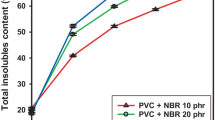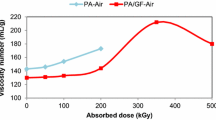Abstract
The physicochemical, thermomechanical, and elastic-strength characteristics of samples based on an oligoetheracrylate binder cured both under the action of only coherent UV radiation and with subsequent aftercuring in a UV oven were studied. It was established by differential scanning calorimetry that full curing of the polymeric matrix is not achieved by coherent UV radiation. The use of additional treatment in a UV oven leads to the formation of a denser three-dimensional cross linking, which increases the brittleness of the polymeric matrix. The introduction of 16A electrocorundum as a filler into the polymeric matrix decreases the thermomechanical and elastic-strength characteristics of an oligoetheracrylate binder regardless of the curing mode.
Similar content being viewed by others
References
V. A. Naumov, Introduction to the Kinetics of Photoinitiated Radical Polymerization of UV Varnishes and Paints (MGUP, Moscow, 2004) [in Russian].
N. G. Vasil’eva, “Innovative technologies in polymerbased printing,” Vestn. Kazan. Tekhnol. Univ. 17 (7), 157–159 (2014).
E. N. Kablov, O. V. Startsev, I. S. Deev, and E. F. Nikishin, “Properties of polymeric composite materials after exposure to open space in circumterrestrial orbits: Part 1,” Vse Mater., Entsikl. Sprav., No. 10, 2–9 (2012).
E. N. Kablov, O. V. Startsev, I. S. Deev, and E. F. Nikishin, “Properties of polymeric composite materials after exposure to open space in circumterrestrial orbits: Part 2,” Vse Mater., Entsikl. Sprav., No. 11, 2–16 (2012).
E. N. Kablov, “Chemistry of aviation materials science,” Ross. Khim. Zh. 54 (1), 3–4 (2010).
E. N. Kablov, B. V. Shchetanov, Yu. A. Ivakhnenko, and Yu. A. Balinova, “Promising reinforcing high-temperature fibers for metal and ceramic composite materials,” Tr. VIAM, No. 2 (2013).
R. R. Mukhametov, K. R. Akhmadieva, L. V. Chursova, and D. I. Kogan, “New polymeric binders for promising methods of manufacture of structural fiber PCMs,” Aviats. Mate. Tekhnol., No. 2, 38–42 (2011).
V. G. Zheleznyak and L. V. Chursova, “Modification of binders and matrices on their basis in order to enhance fracture toughness,” Aviats. Mate. Tekhnol., No. 1, 47–50 (2014).
M. M. Grigor’ev, A. V. Khrul’kov, Ya. M. Gurevich, and N. N. Panina, “Production of fiberglass skins by vacuum infusion using an epoxy anhydride binder and a semipermeable membrane,” Tr. VIAM, No. 2 (2014).
A. N. Babin, “Binders for polymeric composite materials of new generation,” Tr. VIAM, No. 4, 11–24 (2013).
L. V. Chursova, M. A. Kim, N. N. Panina, and E. P. Shvetsov, “A nano-modified epoxy binder for the construction industry,” Aviats. Mate. Tekhnol., No. 1, 40–47 (2013).
D. A. Aronovich, O. A. Sineokova, N. V. Zaitova, et al., “UV-curable anaerobic adhesive compositions,” Polym. Sci., Ser. D 8 (1), 27–32 (2015).
M. Yu. Seregin, “An overview of modern materials and technologies for prototyping,” Perspekt. Nauki, No. 6, 77–79 (2012).
S. N. Matveev, “Modeling of products from polymeric materials by 3D-printing,” Vestn. Kazan. Tekhnol. Univ. 18 (1), 260–262 (2015).
D. V. Gusev, M. A. Larionov, Yu. M. Lipnitskii, and M. Yu. Kulikov, “Application of 3D-printing technology for the manufacture of aerodynamic models of rocket and space technology products,” Kosmonavt. Raketostr. 76 (3), 137–142 (2014).
R. V. Kovalenko, “Modern polymer materials and 3D-printing technologies,” Vestn. Kazan. Tekhnol. Univ. 18 (1), 263–266 (2015).
A. V. Evsseev, M. A. Markov, V. Ya. Panchenko, and V. P. Yakunin, “Acrylic photocurable resins with low viscosity for laser stereolithography,” in Proc. 8th Eur. Stereolithography User Group Meeting (Darmstadt, 1996).
I. E. Malov and I. N. Shiganov, “Features of photopolymerisable compositions for stereolithography with visible lasers,” Inzh. Zh.: Nauka Innovatsii, No. 6, 8 (2012).
M. N. Lysych, R. A. Belinchenko, and A. A. Shkil’nyi, “Materials for 3D-printing,” Aktual. Napravleniya Nauch. Issled. XXI Veka: Teor. Prakt. 4 (3), 200–205 (2014).
A. N. Monyatsi, et al., “Effect of head-to-head addition on vinyl acetate propagation kinetics in radical polymerization,” Macromolecules 47 (23), 8145–8153 (2014).
Author information
Authors and Affiliations
Corresponding author
Additional information
Original Russian Text © A.I. Tsybin, A.I. Tkachuk, T.A. Grebeneva, A.I. Samatadze, M.M. Novikov, 2016, published in Klei, Germetiki, Tekhnologii, 2016, No. 6, pp. 13–19.
Rights and permissions
About this article
Cite this article
Tsybin, A.I., Tkachuk, A.I., Grebeneva, T.A. et al. A study of the performance properties of oligoetheracrylate binder cured by coherent UV radiation. Polym. Sci. Ser. D 10, 13–18 (2017). https://doi.org/10.1134/S1995421217010221
Received:
Published:
Issue Date:
DOI: https://doi.org/10.1134/S1995421217010221




